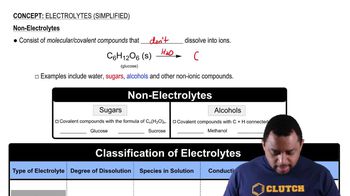Here are the essential concepts you must grasp in order to answer the question correctly.
Dissociation of Electrolytes
Dissociation refers to the process by which an ionic compound separates into its constituent ions when dissolved in water. Strong electrolytes, such as Fe(NO₃)₃, completely dissociate in solution, meaning that all of the compound breaks apart into ions, allowing the solution to conduct electricity effectively.
Recommended video:
Electrolytes (Simplified) Concept 3
Ionic Compounds
Ionic compounds are formed from the electrostatic attraction between positively charged cations and negatively charged anions. In the case of Fe(NO₃)₃, iron (Fe) acts as the cation, while the nitrate ions (NO₃) serve as the anions. Understanding the structure of these compounds is essential for predicting their behavior in solution.
Recommended video:
Balanced Chemical Equations
A balanced chemical equation represents a chemical reaction with equal numbers of each type of atom on both sides of the equation. For the dissociation of Fe(NO₃)₃, it is crucial to write the equation correctly to reflect the stoichiometry of the ions produced, ensuring that the total number of each type of ion is conserved in the reaction.
Recommended video:
Balancing Chemical Equations (Simplified) Concept 1
 Verified step by step guidance
Verified step by step guidance Verified Solution
Verified Solution



 2:38m
2:38m